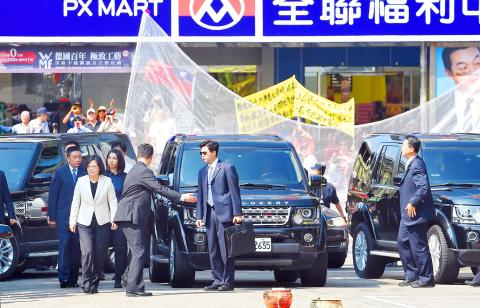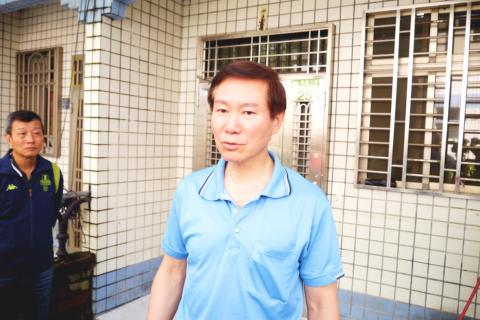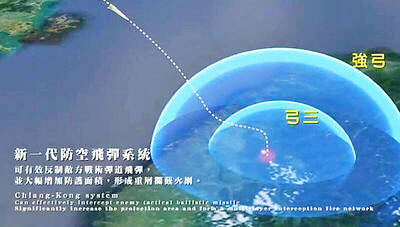High supporter numbers, leaks in the police department and assistance from former police officers are enabling protesters to run effective “guerrilla” campaigns, despite increased security around President Tsai Ing-wen (蔡英文), pension reform opponents said yesterday, adding that “mobile human wall” tactics to keep them away from Tsai’s motorcade would not work.
Protesters have promised to “shadow” Tsai following the passage of pension reforms last month and have had some success in breaking through an increased police presence around the president, including briefly halting her motorcade outside National Defense University in Taipei’s Beitou District (北投) on Thursday last week.
“There are only two roads in and out of the university, so where could she go? The police cannot change the roads,” said Keng Chi-wen (耿繼文), a former director of the National Police Agency’s Internal Affairs Office, who has been one of the most prominent former police officers participating in protests.

Photo: Liu Hsin-de, Taipei Times
Protesters stood along both sides of Zhongyang N Road, moving in front of Tsai’s motorcade as it approached the university entrance before being pushed aside by police.
An increased police presence and barricades around Tsai to keep protesters from getting too close when she arrives at a destination means that “guerrilla” tactics have been used to get close to her, with former police officers who are familiar with presidential security helping show protesters how to congregate and scatter along potential motorcade routes, Keng said.
“We are experts, so it is easy for us to predict the president’s route and backup route,” he said, adding that protesters also often receive leaked information from police.

Photo: Wang Chun-chi, Taipei Times
“We can make quick observations and then divide our forces along potential routes, so there is a chance of blocking her regardless of which way they drive,” he said.
“It might be different if Tsai was just a movie star who could come and go quietly, but presidential security leaves an extremely obvious footprint,” Taiwan Policemen Association executive director Chen Chih-chieh (陳志傑) said, adding that protesters relay signs of police reconnaissance and barricading via social media to predict the president’s movements and mobilize quickly.
“There are different standard operating procedures for the president compared with the vice president or a minister, so we can predict who is coming based on police preparations,” Chen said.
Reports that police plan to begin deploying a “mobile human wall” to counter protesters’ tactics drew disparaging remarks.
“Even if they block off one point, we will just catch Tsai later on,” Keng said.
“Even if the wall succeeds, the sight of policemen being forced to run around would still be embarrassing to Tsai, which is our objective,” Chen said.
It is possible Tsai might be faced with a car suddenly “breaking down” in front of her motorcade, Yunlin County Retired Police Officers Association executive director Lai Kun-yu (賴坤柚) said.

LIMITS: While China increases military pressure on Taiwan and expands its use of cognitive warfare, it is unwilling to target tech supply chains, the report said US and Taiwan military officials have warned that the Chinese People’s Liberation Army (PLA) could implement a blockade within “a matter of hours” and need only “minimal conversion time” prior to an attack on Taiwan, a report released on Tuesday by the US Senate’s China Economic and Security Review Commission said. “While there is no indication that China is planning an imminent attack, the United States and its allies and partners can no longer assume that a Taiwan contingency is a distant possibility for which they would have ample time to prepare,” it said. The commission made the comments in its annual

DETERMINATION: Beijing’s actions toward Tokyo have drawn international attention, but would likely bolster regional coordination and defense networks, the report said Japanese Prime Minister Sanae Takaichi’s administration is likely to prioritize security reforms and deterrence in the face of recent “hybrid” threats from China, the National Security Bureau (NSB) said. The bureau made the assessment in a written report to the Legislative Yuan ahead of an oral report and questions-and-answers session at the legislature’s Foreign Affairs and National Defense Committee tomorrow. The key points of Japan’s security reforms would be to reinforce security cooperation with the US, including enhancing defense deployment in the first island chain, pushing forward the integrated command and operations of the Japan Self-Defense Forces and US Forces Japan, as

IN THE NATIONAL INTEREST: Deputy Minister of Foreign Affairs Francois Wu said the strengthening of military facilities would help to maintain security in the Taiwan Strait Japanese Minister of Defense Shinjiro Koizumi, visiting a military base close to Taiwan, said plans to deploy missiles to the post would move forward as tensions smolder between Tokyo and Beijing. “The deployment can help lower the chance of an armed attack on our country,” Koizumi told reporters on Sunday as he wrapped up his first trip to the base on the southern Japanese island of Yonaguni. “The view that it will heighten regional tensions is not accurate.” Former Japanese minister of defense Gen Nakatani in January said that Tokyo wanted to base Type 03 Chu-SAM missiles on Yonaguni, but little progress

INTERCEPTION: The 30km test ceiling shows that the CSIST is capable of producing missiles that could stop inbound missiles as they re-enter the atmosphere Recent missile tests by the Chungshan Institute of Science and Technology (CSIST) show that Taiwan’s missiles are capable of intercepting ballistic missiles as they re-enter the atmosphere and pose a significant deterrent to Chinese missile threats, former Hsiung Feng III missile development project chief engineer Chang Cheng (張誠) said yesterday. The military-affiliated institute has been conducting missile tests, believed to be related to Project Chiang Kung (強弓) at Pingtung County’s Jiupeng Military Base, with many tests deviating from past practices of setting restriction zones at “unlimited” and instead clearly stating a 30.48km range, Chang said. “Unlimited” restrictions zones for missile tests is